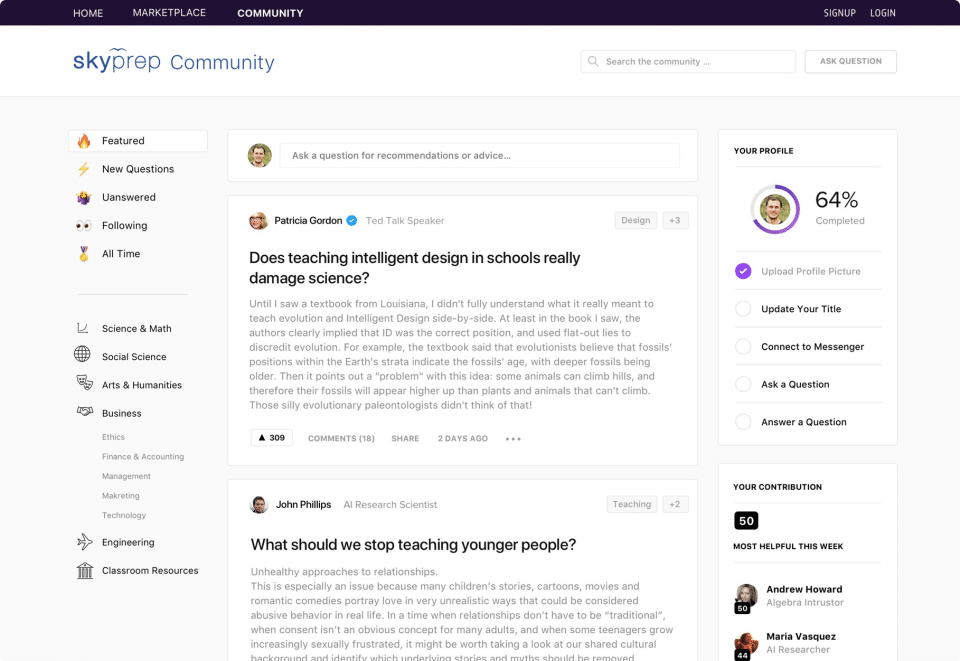
Online communities manifest in many different ways. It could be a passion project of an individual connecting people with a shared interest, an independent creator building a community of followers, or a company trying to connect the customers under its brand. Here, we’re specifically focused on creators and businesses building their tribe on digital platforms. Before we move further, I’d love to highlight this interesting piece by Michael Stelzner in which he talks about how marketers helped Facebook Pages grow and invested millions of advertising dollars to send people to a property that they don’t own.
Eventually, Facebook changed its feed algorithm and the reachability of content posted from Pages reduced significantly unless you’re ready to pay money to reach your own followers. Now Facebook has a newfound priority in Groups because it is becoming harder to harvest data for targeted advertising and people are leaving the platform. Also, it needs people who would create and maintain groups for them.
All these points lead us to some potent questions such as should businesses promote Facebook Groups to the customers and if Facebook would treat Groups the same way it treated Pages.
As an extension to the initial thoughts proposed by Michael, my goal here is to lay out the exact technical details on why a business must think deeply before building a customer community on Facebook.
Read on to explore the pointers.
Data ownership
When you are building your tribe, it is imperative that you own the data generated in the community. This should include everything from the content to the member data. With the data and privacy under your control, you can run analyses to get insights from the discussions.
For example, if you are a business running a Facebook Group where your customers, audiences, and fans discuss your product, there is no way for you to analyze all the user-generated content (UGC). Think about the customer insights you could mine from analytics techniques such as keyword extraction, sentiment analysis, n-gram analysis, etc.
Customization
Every community is unique and the communities differ to a great extent based on the type of audience and the way they connect with the mission or shared value.
Note that the community we join is a part of our identity.
Hence, your community should also reflect that — you must be empowered to pick and choose the social components you need for your community. The way it looks, the terms it uses, and the design language it speaks.
For example, you might want to feature the top members, feed, and highlighted topics in a certain way. Your community must be able to follow your brand guidelines and showcase the logo and color combination, etc.
Discoverability
If you are running a customer community with the goal to increase awareness of your products or services, you’re putting all the valuable user-generated content inside a black box. Think of all the SEO juice you could have accumulated if the content were indexable.
This is absolutely a no-brainer for any business since search engines tend to love UGC.
Integration
Every modern business uses several third-party tools to efficiently run different business functions. And it doesn’t make sense to keep your online community in a silo. So, make sure that your community is integrated with existing tools and processes.
You might want to log community activities of customers in your CRM or create support tickets from the community discussions. Also, the feedbacks and suggestions posted on the community must be easily sent to the Voice of Customer software.
Reporting and analytics
Every business investment must be justified based on the return. If you are not able to access extensive reports on the community health and run analytics to measure how the investment in the online community impacting your business goal, how would you internal buy-in for the project?
Some of the key metrics such as stickiness of the community, member retention rate or comparison of revenue generated from customers who are part of the community and customers who are not members remain inaccessible with FB Groups.
Content organization
It is really difficult to organize the content generated in the Groups based on the topics or subjects. The community must present the content in an easy-to-access manner and suggest the existing content in a contextually.
Automation
If you are using a modern solution, automation must be a key factor for efficiency and productivity. In case of moderation, you should be able to define rules to award a reputation score for the community activity. And based on that create rules for minimum reputation score requirement to post content.
Automatically detecting profanity and setting up blacklisted keywords are two more examples. There are numerous use cases — ranging from automatically converting your WordPress blogs to community discussions to adding members to the community when they subscribe to your offerings.
Embedding social touchpoints
Your community adds vibrancy to your brand. So why not showcase the engagement inside the otherwise static websites or inside your products. By selecting and embedding certain community components on the website you can add social touchpoints in the customer journey.
Two common examples are adding community discussion in the FAQ page to showcase the best possible solutions and featuring community content when your customers are browsing through features inside the product.
Lack of friction-less messaging
When the members of your community would want to take the discussion further and keep private via one-to-one messaging, with FB groups it can have some friction. This is because of the way peer-to-peer messages are handled when two people are not connected. The messages don’t directly appear in the inbox.
Inherent distractions
The Facebook platform is full of distractions — each member in your Group is getting notifications from friends, family, and getting suggested to other similar Groups. Not to forget the ads that the members see from other competing businesses.
When members are engaged in your community, the online space must be focused and must be about your brand only. This is crucial since the attention span is quite fragile.
No sub-groups
What happens when you are interested in building networks in your community by bringing members with a shared passion closer? For example, as a business, you would want to have a sub-community inside your community dedicated to the superusers. Perhaps, a sub-group for newcomers who would graduate to the next stage.
Subgroups are crucial as they act as a channel for member discoverability and bring the members closer via focused discussions.
What are your thoughts?
As a business, do you think the easy-to-access Facebook users and easy setup process outweigh the above-mentioned issues? Or are you fairly concerned about the future of Groups on Facebook?
If you are looking for a Facebook Groups alternative for community building, do check out Tribe Community Platform.

Tribe offers a robust community software that offers a collection of social media best practices for user engagement and matches the requirements of businesses in terms of customizability, brand adaptability, and complete data ownership.

